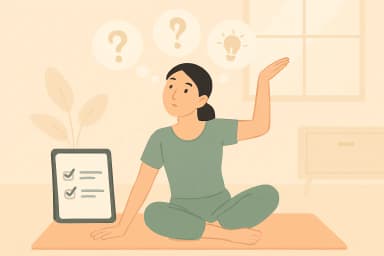
Reviewed by Arisa Tanaphon, Certified Pilates Trainer, Pilates & Mindful Movement Specialist
What to expect: realistic timelines
Pilates transformations don't happen overnight. Unlike crash diets or extreme workouts, Pilates builds strength, flexibility, and body awareness gradually and sustainably. Most people start noticing changes within 4–6 weeks of consistent practice (2–3 sessions per week).
By 8–12 weeks, you'll typically see more noticeable improvements in posture, core strength, and overall body alignment. Long-term changes (3–6 months) include significant improvements in muscle tone, flexibility, and reduced chronic pain.
Remember: everyone's body responds differently. Factors like your starting fitness level, consistency, genetics, and lifestyle all play a role in how quickly you see results.
Physical changes you'll notice
- Improved posture: shoulders back, spine aligned, head held high
- Stronger core: better abdominal definition and stability
- Longer, leaner muscles: Pilates emphasizes elongation over bulk
- Better balance: improved proprioception and coordination
- Reduced body tension: less stiffness in neck, shoulders, and back
- Enhanced flexibility: greater range of motion in hips, shoulders, and spine
Posture and alignment improvements
One of the most visible Pilates transformations is improved posture. Many people start with rounded shoulders, forward head posture, and a curved spine from hours of desk work or phone use.
Pilates focuses on spinal alignment, core engagement, and proper muscle activation. Within 6–8 weeks of regular practice, you'll likely notice:
- Shoulders naturally rolling back and down
- Head sitting directly over your shoulders (not forward)
- Spine maintaining its natural curves
- Hips aligned with your shoulders and ankles
- Standing taller with less effort
Take a quiz
Answer a few quick questions to see if Asian Pilates fits your goals.
Is Asian Pilates for me?

Strength and muscle tone
Pilates builds functional strength that translates to daily life. Unlike traditional weight training that focuses on isolated muscle groups, Pilates works your entire body as an integrated system.
You'll develop:
- Deep core strength: transverse abdominis, pelvic floor, and deep back muscles
- Full-body integration: muscles working together, not in isolation
- Functional strength: movements that help you in daily activities
- Endurance: ability to hold positions and maintain form longer
Flexibility and mobility
Pilates combines strength training with flexibility work, creating long, supple muscles rather than short, tight ones. This is especially important as we age, when flexibility naturally decreases.
Within 4–6 weeks, you'll likely notice:
- Greater range of motion in hips and shoulders
- Easier forward folds and backbends
- Less stiffness when getting out of bed or standing up
- Smoother, more fluid movements throughout the day
Pain relief and injury prevention
Many people turn to Pilates because of chronic pain—especially lower back pain, neck tension, or joint discomfort. Research shows that Pilates can significantly reduce pain and improve function in people with chronic conditions.
Studies have found that 8–12 weeks of Pilates practice can lead to:
- Reduced lower back pain and improved function
- Less neck and shoulder tension
- Improved joint mobility and reduced stiffness
- Better body mechanics that reduce strain on vulnerable areas
Mental and emotional benefits
Pilates transformations aren't just physical. The mindful, focused nature of Pilates practice also brings mental and emotional benefits that many people notice within the first few weeks:
- Reduced stress and anxiety through mindful movement and breathing
- Improved body confidence as you feel stronger and more capable
- Better sleep quality from reduced tension and improved relaxation
- Increased self-awareness and connection to your body
- Sense of accomplishment from mastering new movements
Why consistency matters
The key to seeing real Pilates transformations is consistency. Practicing 2–3 times per week for 8–12 weeks will yield much better results than sporadic, intense sessions.
Think of Pilates as building a foundation: each session builds on the previous one. Your body needs time to adapt, strengthen, and integrate the movements. Skipping weeks or practicing inconsistently slows down progress.
Most people see the best results when they:
- Practice 2–3 times per week consistently
- Focus on quality over quantity (better to do fewer, well-executed movements)
- Listen to their body and rest when needed
- Combine Pilates with other healthy habits (good sleep, nutrition, hydration)
Setting realistic expectations
It's important to set realistic expectations for your Pilates journey. While some people see dramatic changes quickly, most transformations happen gradually over months, not days.
Focus on how you feel, not just how you look. Many of the most valuable Pilates benefits—better posture, reduced pain, improved flexibility, increased strength—are felt before they're visible.
Remember: Pilates is a practice, not a quick fix. The real transformation happens when you make Pilates a sustainable part of your lifestyle, not a short-term challenge.




